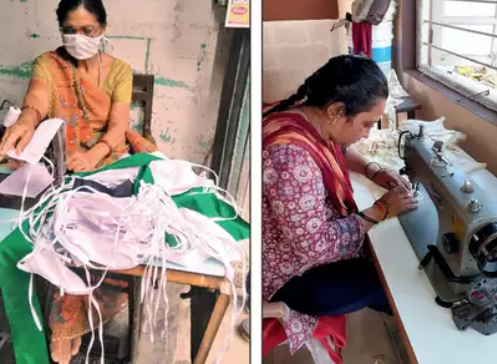GUJARAT, INDIA – Self-Employed Women’s Association (SEWA) has produced and distributed as many as 5 lakh masks for use in the battle against COVID-19. The organization, with about 1.7 million women workers in about 18 states, started making masks as early as March 18, ahead of the nationwide lockdown.
“Women living in rural areas can’t afford surgical or N-95 masks. Initially, about 4-5 women learned how to make masks at home. They made a video and circulated it among others. At the health centres, a master trainer is appointed to train others and maintain quality standards. So far, we have distributed 5 lakh masks produced by 500 women,” said Reema Nanavaty, director of SEWA.
While the masks are distributed for free to the villages the women have also been getting bulk orders from clients.
The masks have been priced at affordable rates. While the cost of double-layered mas is about Rs 7-10 per piece, the single-layered ones cost anywhere between Rs 3-5 per mask. The masks undergo rigorous quality and standardization check where the women are to upload videos of the masks to be scrutinized by a district-level coordinator. The 500 women are in various districts across different states.
“Women and their families are engaged in meaningful and productive work in making masks. Also, it can save women from becoming targets of domestic stress during the lockdown period for she can continue to earn using her skills,” Nanavaty said.
Children of the underserved communities are losing out on crucial months of schooling owing to the lockdown, and often difficult domestic situations are made worse by being forced to stay in close quarters. Also, the houses themselves are mostly small and densely populated, which adds to the stress generated by fear of coronavirus.
“SEWA also realized that this was a good opportunity to connect the children with their roots, whether in relation to traditions, festivals, recipes or even crafts. We are also focusing on nurturing a relationship between the children and nature by promoting the upkeep of a nature journal, teaching bird watching and sustainable agricultural practices,” said Nanavaty.
In regions of Patan and Surendranagar, children of salt-pan workers have been asked to keep a diary highlighting the lives of their parents and themselves; from the hardships faced by them to the use of technology in their lives. Similarly, adolescent girls of Kutch and Patan are being encouraged to learn their traditional styles of embroideries which are losing favor with the younger generation, she added. (Maulik Pathak, The Times of India, 13 April 2020)




Comments are closed